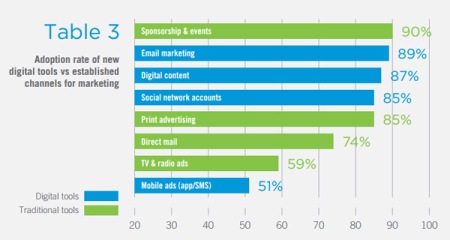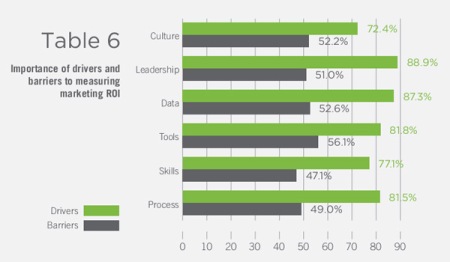 In this technology-driven age, a common challenge for companies has been integrating new technologies into their existing business models, marketing and operations. This has been said to remain true for luxury brands. Convention has held that digital commerce is for the penny-wise. Research and consulting firm McKinsey dispels this perception. It reported that nearly 50% of luxury purchases are in fact influenced by digital. Warc’s Darika Ahrens aptly notes, “High-end income earners love high-end technology.”
In this technology-driven age, a common challenge for companies has been integrating new technologies into their existing business models, marketing and operations. This has been said to remain true for luxury brands. Convention has held that digital commerce is for the penny-wise. Research and consulting firm McKinsey dispels this perception. It reported that nearly 50% of luxury purchases are in fact influenced by digital. Warc’s Darika Ahrens aptly notes, “High-end income earners love high-end technology.”
Recognizing this, luxury fashion brand Rebecca Minkoff, an early adopter of new technologies in retail, is leading the way in immersive experiences that touch upon all senses to resonate with these digital-savvy, affluent consumers. Speaking at the Center  on Global Brand Leadership’s BRITE ’15 conference, Emily Culp, Rebecca Minkoff’s SVP of eCommerce and Omni-Channel Marketing, discussed driving customer lifetime value by delivering multi-faceted experiences derived from technology, insights and organizational structure.
on Global Brand Leadership’s BRITE ’15 conference, Emily Culp, Rebecca Minkoff’s SVP of eCommerce and Omni-Channel Marketing, discussed driving customer lifetime value by delivering multi-faceted experiences derived from technology, insights and organizational structure.
In 2014, Rebecca Minkoff launched its “Connected Stores” in New York and San Francisco. Culp explained that by leveraging beacon technology and RFID tags, Rebecca Minkoff offers consumers an even more personalized, integrated experience. “When [our customer] walks into the fitting room, it  recognizes merchandise and gives recommendations on what to wear [the item] with.” Interactive dressing room mirrors entice customers to browse video and content, order complimentary beverages, save merchandise options to their devices via the Rebecca Minkoff app, and check in-store and online inventory. Customers can even adjust fitting room lighting to reflect the setting in which they would don the outfit (i.e. “SoHo after dark”).
recognizes merchandise and gives recommendations on what to wear [the item] with.” Interactive dressing room mirrors entice customers to browse video and content, order complimentary beverages, save merchandise options to their devices via the Rebecca Minkoff app, and check in-store and online inventory. Customers can even adjust fitting room lighting to reflect the setting in which they would don the outfit (i.e. “SoHo after dark”).
In developing experiences for their omni-channel consumer, the question Culp asks herself is straightforward: “How do we flawlessly execute this omni-channel marketing in such a complex ecosystem?” At BRITE ’15, she outlined four essential points to succeed at this:
- Leadership: the ability to embrace smart risk and experimentation
- Expertise: building teams with hybrid skill-sets (e.g. creativity combined with an understanding of metrics)
- Linkage: breaking down the silos to align the KPIs of different departments
- Communication: sharing insights even when they may seem irrelevant to another team. “Maybe they can take it in a different way that another hasn’t [considered],” explained Culp.
In particular, culling data from all touchpoints is at the foundation of their approach. “A lot of people think that data is boring,” she explains. “I inherently think this is one of the most creative and fascinating parts of marketing today.” Quantitative and qualitative insights paint a holistic picture of their consumer. “[W]e can see as she traverses across these different channels what her behavior is and help her make informed decisions when it’s right for her.”
Through research, Culp’s team discovered that their consumer checks her smartphone, on average, 150 times a day, spiking at different points depending on when she’s at work using her computer or at night on her tablet. “The constant is mobile. So for us, when we’re looking at omni-channel marketing… we start with mobile.”

Culp stresses the importance of not employing technology for technology’s sake. It should have a purpose. For Rebecca Minkoff, it’s using technology to seamlessly deliver value to consumers, relieving pain-points and empowering them to make informed decisions while shopping in-store and on any device at any time, anywhere in the world.
Check out Emily Culp’s talk at BRITE ’15 to hear more on developing omni-channel innovations and experiences to drive long-term value.
BY ALLIE ABODEELY


 Educating customers about the use of new products will make or break your brand. In Nakumatt stores, for example, shoppers tried to put black mascara on their lips because they didn’t know what it was for. Now, according to the
Educating customers about the use of new products will make or break your brand. In Nakumatt stores, for example, shoppers tried to put black mascara on their lips because they didn’t know what it was for. Now, according to the 




